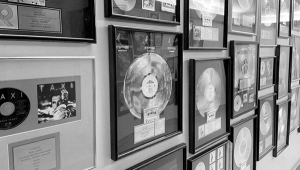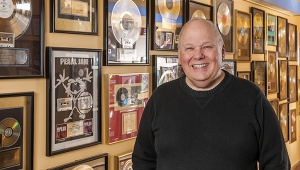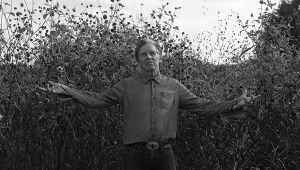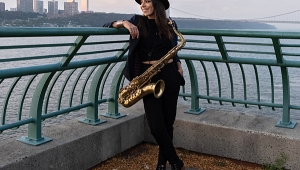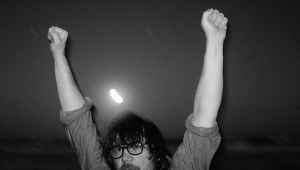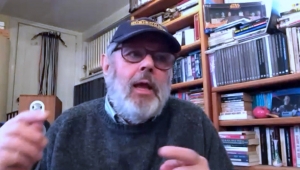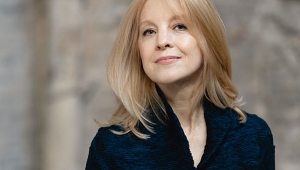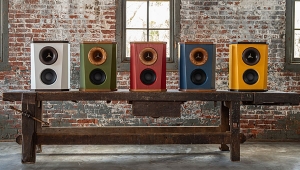| Columns Retired Columns & Blogs |
A Glorious Time: AR's Edgar Villchur and Roy Allison Villchur Part 2
Lander: Some years after the acoustic-suspension woofer, you designed the first dome tweeter. You've said it was initially intended for the AR-1, because the driver made for you wasn't up to the quality of the woofer, and because you were relying on a competing company for it. How long did that project take, and why did you decide on a dome configuration?
Villchur: Building the woofer prototype was a matter of a couple of weeks, but this took a year and a half. Of course, I had other things to do. As for the dome, it wasn't so much the shape of the diaphragm as the fact that the diaphragm can be made very small while the speaker still carries adequate power. This is accomplished by putting the voice-coil at the large diameter of the diaphragm rather than at the small diameter. A small radiator provides the best dispersion and power response, along with extended, smooth high-frequency response. A different shape could be used for the diaphragm, but it would have a greater tendency to break up. The AR-3 was the first speaker to use the dome tweeter, which wasn't imitated in other speaker systems for about 10 years.
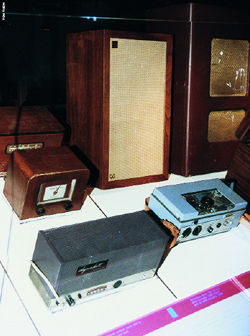 Lander: In 1956, you were awarded a patent for the acoustic-suspension speaker. You wrote the description yourself rather than relying on a patent attorney. Why?
Lander: In 1956, you were awarded a patent for the acoustic-suspension speaker. You wrote the description yourself rather than relying on a patent attorney. Why?
Villchur: The estimate the patent attorney gave me was too high. I said, "How about if I just come talk to you and you tell me what I need to do to write my own? How much would you charge for that?" He said, "$30 an hour," and I said, "I'll take one."
Lander: But a 1962 court ruling found your patent invalid because of one that Harry Olson and John Preston, an RCA colleague, had gotten in 1949. How did that come about?
Villchur: We filed a suit against Electro-Voice for patent infringement. We already had licensees, KLH and Heathkit, that were paying us royalties. Rather than pay, Electro-Voice offered us an exchange deal for a useless patent of theirs. So we had to sue.
Lander: Do you think using an attorney at the time you applied for your patent would have prevented the ruling against you?
Villchur: Yes. He would have had a thorough patent search made. If I had been aware of the Olson patent beforehand, it would have been easy to protect my patent, which was quite different. But sufficient protection wasn't written in because I hadn't had an adequate patent search made. Again, a matter of money.
Lander: What did the Olson patent actually describe?
Villchur: The central feature was a compliant-mechanical-rim suspension design. There was no general claim for a system that had a speaker mechanism with a free-air resonance frequency substantially below its optimum operating resonance, and which therefore required a small enclosure. That's what an acoustic-suspension system is, but the judge, who was totally nontechnical, ruled against us. I guess I feel vindicated by the fact that the Smithsonian Institution, in its exhibition on the history of technology, shows two speakers: a bass-reflex unit and the AR-3.
Lander: When asked why you chose not to appeal the ruling, you've cited the example of Edwin Armstrong, who invented the superheterodyne circuit and FM radio.
Villchur: He spent his life in litigation. I figured, "Why waste my time? I have better things to do."
Lander: One of them was promoting AR, and one way you did that was with live-vs-recorded music demonstrations. Audiences at those events got to compare a live string quartet with recordings of the same musicians playing the same pieces.
Villchur: We did them all over the place. We did one at Carnegie Recital Hall. The Washington Post gave us half a page when we rented a hall and did it there. We got tremendous publicity. Then we opened up the Music Room in Grand Central.
Lander: That was an offshoot of a display established by Milton Sleeper, a founder of High Fidelity. It was in New York City's Grand Central Terminal, where the traffic is unbelievable and a lot of people have nothing to do while waiting for trains.
Villchur: We bought it from him and revamped it so that it looked entirely different and, most important, sounded good. One year we counted a hundred thousand visitors.
Lander: You also maintained a similar facility in Cambridge, Massachusetts. And you had a demo room at the 1963 World's Fair, in New York. AR speakers were never sold in those places, but they must have done a lot for sales.
Villchur: Stereo Review used to do an annual survey [of market share by component category]. In the late '50s, we became number one in speakers, and our share increased and increased.
Lander: In 1966, the year before you sold the company, Stereo Review put AR's share at just over 32% of the speaker market.
Villchur: And number two would have been 10 or 12%.
Lander: Along with innovative speakers, which you backed with blue-chip warranty service, the textbook-quality ads you wrote, and ingenious promotion, your unique style of running a company had to be a factor in your success. For one thing, you gave your employees substantial benefits. Tell us about that.
Villchur: We had medical insurance for everybody, unheard of in the late '50s, especially for a company our size. And we had profit sharing, which is meaningful only when wages are up to scale or better. We had twice-yearly meetings at which I'd announce what the profit sharing was. The highest figure was 21% of earnings for half a year. That was for the ordinary joe; foremen and top management got more. While it's what I believed in, it really is very good business, because the employees know that the better the quality of their work, the more their bonuses will be. We also made it clear to them that when something comes back because it fails, it takes far more out of the profit-sharing kitty than it ever contributed. Profit sharing stimulated efficient but careful work.
Lander: Tell us about the genesis of the legendary AR turntable, which Roy told me was your baby.
Villchur: I wanted to make a complete system, and I thought the next thing should be a turntable, because our forte was mechanical rather than electronic. I hired a consultant for the job, but about a year and a half and maybe $25,000 later, what he had was useless. So I had to do it, and I did almost all of it in my lab in Woodstock in the late '50s and early '60s, just after the AR-3. We thought we could bring it out at $58, but that was an error. Not too long afterward, we had to raise it to $78—complete, with everything but a cartridge. By that time, we had a reputation. When we announced we were bringing out a turntable, we had orders for thousands.
When I brought the prototype in from Woodstock, Abe said to me, "How many of these are we going to sell?" And I said, "How should I know?" He said, "Well, you have to make an estimate, because I have to know what to invest in tooling." So I said, "Okay. I'll be optimistic. I believe in this thing. It's a superior device. We're going to sell 50,000 of them before we're through." About 10 years after that—I was long gone from AR, and I was talking to Roy—I asked, "How's the turntable doing?" He said, "It's doing okay. We'll sell maybe 50,000 this year."
Lander: However long gone you may be from AR, you maintain strong views about hi-fi. In fact, you initially balked at doing this interview because you feel that many aspects of high-end audio, such as expensive cables and equipment break-in, are meaningless.
Villchur: The concluding paragraph of a talk I once gave at an Acoustical Society meeting sums that up. I'll read you part of it: "Scientific method allows investigators to form hypotheses in any way they please: out of a cold assembly of facts, intuition, or a drunken stupor....Once a hypothesis is proposed, however, it must be demonstrated rigorously. The audio discipline needs to be brought back to the world of reason."
Lander: Is there room in that world for subjectivity?
Villchur: Objective measurements in audio are primary, but they're useless unless they've been subjectively validated as predictors of musical accuracy. The validation method we used at Acoustic Research was the live-vs-recorded, or simulated live-vs-recorded, comparison. The standard I use today is set by our Woodstock chamber music concerts.
- Log in or register to post comments

